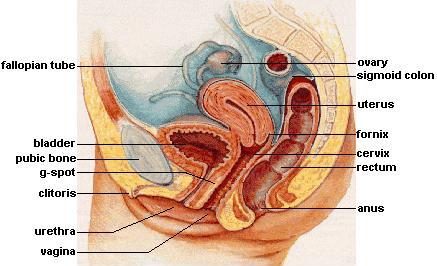How your glandular system works
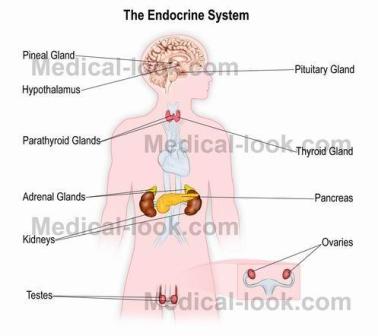
The glandular system regulates the activities of the body by secreting chemical substances (hormones) into the blood stream. These secretions come from a variety of glands which influences almost every cell, organ, and function of our bodies. The endocrine system is instrumental in regulating mood, growth and development, tissue function, metabolism, sexual function and reproductive processes.
The endocrine system uses chemicals to “communicate” to and from various parts of the body. These chemicals are known as hormones. Each hormone’s shape is specific and can be recognized by the corresponding target cells.
Low concentrations of a hormone will often trigger the gland to secrete. Once the concentrations of the hormone in the blood rise this may cause the gland to stop secreting, until once again hormone concentrations fall. This feedback mechanism (which is characteristic of most glands) causes a cycle of hormone secretions.
Once hormones have served their function on their target organs/tissues they are destroyed. They are either destroyed by the liver or the actual tissues of the target organs. They are then removed by the kidneys.
The major glands that make up the human endocrine system include the:
Hypothalamus
The hypothalamus is located in the lower central part of the brain. It is the main link between the endocrine and nervous systems. Nerve cells in the hypothalamus control the pituitary gland by producing chemicals that either stimulate or suppress hormone secretions from the pituitary. It is the gland that monitors what is happening in the body and then instructs the pituitary gland on what needs to be done.
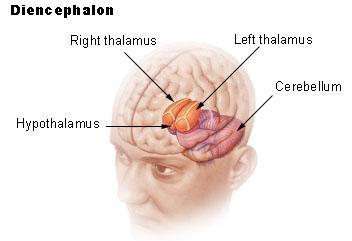
Pituitary gland
Although it is no bigger than a pea, the pituitary gland, located at the base of the brain just beneath the hypothalamus, is considered the most important part of the endocrine system. It’s often called the “master gland” because it makes hormones that control several other endocrine glands. The production and secretion of pituitary hormones can be influenced by factors such as emotions and changes in the seasons. To accomplish this, the hypothalamus provides information sensed by the brain (such as environmental temperature, light exposure patterns, and feelings) to the pituitary.
The tiny pituitary is divided into two parts: the anterior lobe and the posterior lobe. The anterior lobe regulates the activity of the thyroid, adrenals, and reproductive glands. The posterior lobe of the pituitary releases anti diuretic hormone, which helps control the balance of water in the body. The posterior lobe also produces oxytocin, which triggers the contractions of the uterus in a woman having a baby.
The pituitary also secretes endorphins, chemicals that act on the nervous system and reduce feelings of pain. In addition, the pituitary secretes hormones that signal the reproductive organs to make sex hormones. The pituitary gland also controls ovulation and the menstrual cycle in women.
Pineal gland
The pineal gland is located in the middle of the brain and is stimulated by nerves from the eyes. The pineal gland secretes melatonin at night when it’s dark, thus secretes more in winter when the nights are longer. Melatonin promotes sleep and also affects reproductive functions by depressing the activity of the gonads. Additionally, it affects thyroid and adrenal cortex functions.
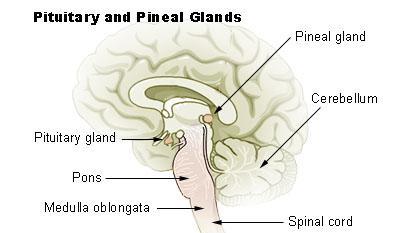
Thyroid
The thyroid, located in the front part of the lower neck, is shaped like a butterfly and produces the thyroid hormones thyroxine and triiodothyronine. These hormones control the rate at which cells burn fuels from food to produce energy. The production and release of thyroid hormones is controlled by thyrotropin, which is secreted by the pituitary gland. The more thyroid hormone there is in a person’s bloodstream, the faster chemical reactions occur in the body.
Thyroid hormones regulate metabolism, therefore body temperature and weight. The thyroid hormones contain iodine, which the thyroid needs in order to manufacture these hormones. If a person lacks iodine in his/her diet, the thyroid cannot make the hormones, causing a deficiency. In response to the body’s feedback loops calling for more thyroid hormones, the thyroid gland then enlarges to attempt to compensate (The body’s plan here is if it’s bigger it can make more, but that doesn’t help if there isn’t enough iodine.). This disorder is called goitre.
Under-secretion of thyroid hormone in children produces cretinism; the children show stunted growth (dwarfism) and fail to develop mentally. Under secretion in adults results in a low metabolic rate. Over secretion in adults gives rise to exophthalmic goitre and the metabolic rate is higher than usual. Such persons may eat well but burn up so much fuel that they remain thin. This is usually accompanied by a rapid pulse rate. This gland, therefore, has a profound influence on both mental and physical activity.
The Parathyroid Glands
Attached to the thyroid are four tiny glands that function together called the parathyroids. They release parathyroid hormone, the function of which is to raise the blood calcium as well as maintain the balance of calcium and phosphorus in both the blood and bone structures. Under secretion gives rise to a condition known as tetany in which the muscles go into spasm, and over secretion causes calcium to be lost to the blood from the bones giving rise to softened bones, raised blood calcium and a marked depression of the nervous system.
Calcium is important, not only for bones and teeth, but also for nerve functioning, muscle contractions, blood clotting and glandular secretion. If we don’t have enough calcium for these functions, the body will take it from the bones, causing them to easily fracture. It may also cause twitching, spasms, convulsions and even death. Too much calcium may cause a weakening of muscle tone and kidney stones.
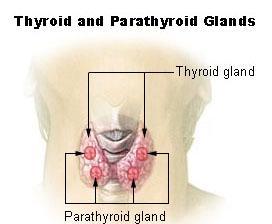
The Thymus Gland
This gland lies in the lower part of the neck and attains a maximum length of about 6cm. It is made up of two lobes that join in front of the trachea. Each lobe is made of lymphoid tissue, consisting of tightly packed white blood cells and fat. The thymus enlarges from about the 12th week of gestation until puberty. After puberty, the thymus begins to atrophy so that in the adult only fibrous remnants is found. Its secretion is thought to act as a brake on the development of sex organs so that as the thymus atrophies, the sex organs develop.
Its function is to transform lymphocytes (white blood cells developed in the bone marrow) into T-cells (cells developed in the thymus). These cells are then transported to various lymph glands, where they play an important part in fighting infections and disease. Swelling of lymph glands and fever are a signal that immune cells are multiplying to fight off invaders of the body: bacteria, fungi, viruses or parasites.
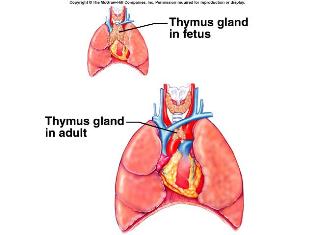
Adrenal glands
The body has two triangular adrenal glands, one on top of each kidney. The adrenal glands have two parts, each of which produces a set of hormones and has a different function.
The outer part, the adrenal cortex, produces hormones called corticosteroids. There are three main types: those which control the balance of sodium salt and potassium in the body (salt and water levels); those which raise the level of sugar in the blood; and sex hormones. This cortex, or outer, yellow layer, takes its instructions from the pituitary hormone ACTH.
The smaller, inner region is part of the sympathetic nervous system and is the body’s first line of defense and response to physical and emotional stresses. This inner, reddish brown layer makes two types of hormones and takes all its instructions from the nervous system, producing chemicals which react to fear and anger and are sometimes called “fight or flight” hormones called catecholamines. One of these, called epinephrine or adrenaline, increases blood pressure and heart rate when the body experiences stress.
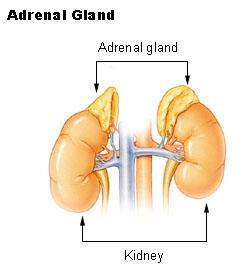
The Pancreas
The pancreas is a long, narrow, lobed gland located behind the stomach.
This organ has two functions. It secretes digestive enzymes into the small intestine, which break down fats, carbohydrates, proteins and acids. It also secretes bicarbonate, which neutralizes stomach acid as it enters the duodenum.
It also has endocrine cells which are arranged in clusters throughout the Pancreas, these are known as Islets of Langerhans. They secrete insulin and glucagon to regulate the blood sugar level. Glucagon tells the liver to take carbohydrate out of storage to raise a low blood sugar level. Insulin tells the liver to take excess glucose out of circulation to lower a blood sugar level that’s too high. If a person’s body does not make enough insulin (and/or there is a reduced response of the target cells in the liver), the blood sugar rises, perhaps out of control, and we say that the person has diabetes mellitus.
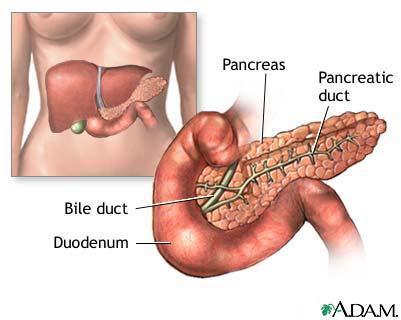
Male Hormone System
The entire male reproductive system is dependent on hormones, which are chemicals that stimulate or regulate the activity of cells or organs. The primary hormones involved in the functioning of the male reproductive system are follicle-stimulating hormone (FSH), luteinizing hormone (LH) and testosterone.
FSH and LH are produced by the pituitary gland. FSH is necessary for sperm production (spermatogenesis), and LH stimulates the production of testosterone. Testosterone is important in the development of male characteristics, including muscle mass and strength, fat distribution, bone mass and sex drive. Testosterone as well as sperm cells, are produced in the testes.
The prostate is a gland of the male reproductive system that produces fluid for semen, which helps to transport sperm during the male orgasm. The prostate is made up of about 30% muscular tissue; the rest is glandular tissue. The prostate is about the same size and shape as a walnut and is located in front of the rectum and just below the bladder. The prostate wraps around the urethra, which is the tube that carries urine out from the bladder through the tip of the penis.
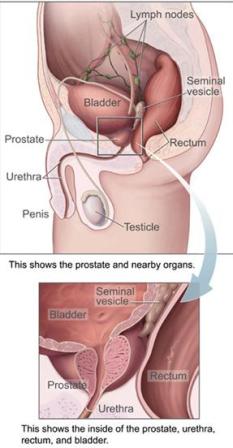
Female Hormonal System
The hypothalamus produces gonadotropin-releasing hormone, which stimulates the pituitary gland to produce luteinizing hormone and follicle-stimulating hormone. These hormones stimulate the ovaries to produce the female sex hormones, estrogen and progesterone, and some male sex hormones (androgens). (Male sex hormones stimulate the growth of pubic and underarm hair at puberty and maintain muscle mass in girls as well as boys.) After childbirth, the hypothalamus signals the pituitary gland to produce prolactin, a hormone that stimulates milk production. The adrenal glands produce small amounts of female and male sex hormones.
At puberty, when the ovaries and uterus are mature enough to respond to hormonal stimulation, certain stimuli cause the hypothalamus to start secreting gonadotropin-releasing hormone. This hormone enters the blood and goes to the anterior pituitary gland where it stimulates the secretion of follicle-stimulating hormone and luteinizing hormone. These hormones, in turn, affect the ovaries and uterus and the monthly cycles begin. A woman’s reproductive cycles last from menarche to menopause.
Menopause occurs when a woman’s reproductive cycles stop. This period is marked by decreased levels of ovarian hormones and increased levels of pituitary follicle-stimulating hormone and luteinizing hormone. The changing hormone levels are responsible for the symptoms associated with menopause.
